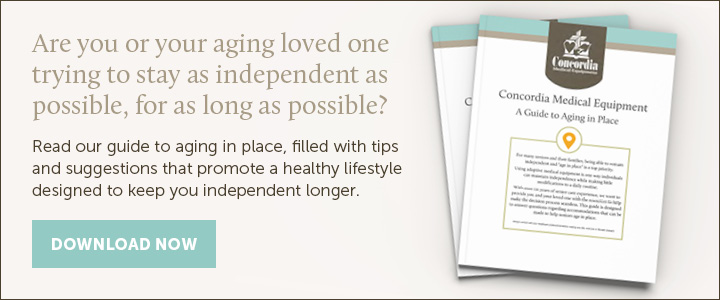Fall Prevention Awareness: Tips to Prevent Injury and Safely Age in Place

Did you know that September 23, 2019 is Fall Prevention Awareness Day? For many of us, fall prevention becomes increasingly important as we age. According to the CDC, over 3 million senior adults in the U.S. are treated in emergency rooms for fall-related injuries each year. Of that figure, one in five seniors will have a serious injury resulting in increased health problems later on.
Despite this statistic, there are many ways to decrease the risk of fall-related hazards and injuries. Proactively taking precautions by making minor home alterations, taking care of your health and using assistive devices decreases the likelihood of experiencing a fall or injury, and can help you safely age in place. Below are several tips and recommendations about ways to reduce fall risk.
Common Risk Factors for Fall Injury
There are many reasons why the risk of falling increases as we age. As our bodies get older, our vision, muscle strength, reaction time and coordination diminishes. Additionally, many chronic illnesses such as low blood pressure (hypotension), diabetes and heart disease – to name a few – can cause a loss of balance, numbness in certain areas of the body, dizziness and more. Medications for certain illness can also present side effects that increase fall risk.
Home Safety Fall Prevention
Seniors who live alone in their home are more likely to experience greater safety concerns and have an increased risk of falling. By making minor accommodations listed below, as well as taking additional preventative measures, your risk factor significantly decreases.
1. Brighten Walkways and Darkened Areas Around the Home – Many injuries are often a result of inadequate lighting in hallways at night. Increase lighting throughout hard-to-see areas and high-traffic walkways. Even small plug-in lights that brighten up an area can have considerable long-term impact. Remember to install lighting around the exterior parts of the home as well, especially around porch steps and pathways.
2. Clean Up Excess Clutter – Eliminate clutter and anything that can impede a direct walking path (throw rugs, mats, extension cords, boxes, etc.) Open living spaces are less likely to present a fall risk.
3. Use Non-Slip Devices – Non-slip adhesive mats are an important tool to place in areas with non-carpeted flooring. Ensure that mats are securely placed on any exposed flooring or tile.
4. Install Handrails – Install handrails at the correct height on stairs and elevated walkways. Additionally, grab bars in bathrooms near the shower or tub area are important to have.
5. Modify Home Exterior – In addition to installing outdoor lighting, make smaller changes to any areas outside of your home that could present a fall risk. Outdoor furniture should be arranged so that it does not impede walkways, outdoor steps should be in good overall condition – free from any weathered or exposed materials – and railings should be secured. During the winter months, take extra precaution when traveling outdoors and ask for assistance with snow and ice removal.
Use Assistive Devices to Prevent Falls
Assistive devices offer mobility support and assistance with the activities of daily living. There are different types of assistive devices, including adaptive mobility equipment and daily living aids. Many devices, including grab bars, vision aids, canes, walkers, rollators and more, improve mobility and greatly reduce the risk of a fall, especially when traveling outside of a home environment. After purchasing adaptive equipment, ensure that devices are correctly sized and are used for their intended purposes. For help with choosing the right device to meet your needs, consult with your healthcare team.
Prioritize Your Health to Prevent Injury
One of the most important ways to prevent fall risk is to take care of your health. Discuss any current medications that may increase your likelihood of falling with your primary care physician. Your healthcare provider may also be able to provide an assessment for fall risk based on your health history. Additionally, a regular wellness routine that incorporates low-impact exercises can improve coordination, muscle strength and balance.
There are many ways to make an environment safer and reduce the chances of experiencing a fall or injury. Prioritizing your healthcare needs and making minor modifications within a home environment can increase overall individual safety and better allow you to age in place.
Concordia is hosting a free Fall Prevention Awareness Event that is open to the public on Monday, September 23 from 1 – 3 p.m. at the Concordia at Cabot campus Haven I building, 112 Marwood Rd., Cabot, PA 16023. To learn more about this event, visit the listing on the Events and News page of our website. You can also message us through the Contact form on our website 24 hours a day.
Get Updates From Concordia
There is always a LOT happening at Concordia! Would you like to stay up-to-date with our news and events? Sign up for our monthly e-newsletter here.
